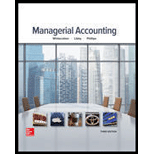
Concept explainers
Concept introduction:
Cost Volume Profit (CVP) Analysis:
The Cost Volume Profit analysis is the analysis of the relation between cost, volume, and profit of a product. It analyzes the cost and profits at the different level of production, in order to determine the breakeven point and required the level of sales to earn the desired profit.
Contribution margin means the margin that is left with the company after recovering variable cost out of revenue earned by selling smart phones. The formula for contribution margin is as follows:
Contribution margin = Sales - Variable cost.
Similarly contribution margin ratio = Contribution/sales
Weighted Average Contribution Margin:
Weighted Average Contribution Margin is calculated for two products with the help of following formula:
To calculate:
The Breakeven Sales
Want to see the full answer?
Check out a sample textbook solution
Chapter 6 Solutions
Managerial Accounting
- APPLY THE CONCEPTS: Target income (sales revenue) Another useful method for figuring out the type of performance your company will need to reach a target income is by using sales revenue. Rather than using the number of units, this method uses total sales revenue. In companies for which the total set of goods produced and sold is more varied, this would be the preferred method, as opposed to a business in which only one product is sold. Assume a company has pricing and cost information as follows: Price and Cost Information Amount Selling Price per Unit $30 Variable Cost per Unit $15 Total Fixed Cost $15,000 For the upcoming period, the company wishes to generate operating income of $40,000. Given the cost and pricing structure for the company's product, how much sales revenue must it generate to attain its target income? Step 1: Calculate the contribution margin ratio: The contribution margin ratio is the contribution margin in proportion to the selling price on a per-unit basis.…arrow_forwardWildhorse Repairs has 200 auto-maintenance service outlets nationwide. It performs primarily two lines of service: oil changes and brake repair. Oil change-related services represent 70% of its sales and provide a contribution margin ratio of 20%. Brake repair represents 30% of its sales and provides a 40% contribution margin ratio. The company's fixed costs are $13,416,000 (that is, $67,080 per service outlet). Sales mix is determined based upon total sales dollars. (a) Your answer is correct. Calculate the dollar amount of each type of service that the company must provide in order to break even. (Use Weighted- Average Contribution Margin Ratio rounded to 2 decimal places e.g. 0.25 and round final answers to 0 decimal places, e.g. 2,510.) Sales Dollars Needed Per Product Oil changes Brake repair $ 36120000 15480000arrow_forwardCost Volume Profit Analysis Break-Even Point, CM ratio, Margin of Safety (6.50) Universal product distributes single product a woven basket whose selling price is Rs.15 and variable expense is Rs.12 per unit. The company’s monthly fixed expense is Rs. 4,200. Required: Using Equation method: Compute break-even point in unit sales. (1.0) Compute break-even point in sales dollars and contribution margin ratio. (1.0) Using Formula method: Compute break-even point in unit sales. (1.0) Compute break-even point in sales dollars and CM ratio. (1.0) MC distributes sun umbrella for resort hotels. Data concerning next month’s budget appears below: Selling price Rs. 30 per unit Variable expenses Rs. 20 per unit Fixed expenses Rs. 7,500 per month Unit sales…arrow_forward
- Blossom Company has the following information available for September 2022. Unit selling price of video game consoles Unit variable costs Total fixed costs Units sold $400 $320 $24,000 600arrow_forwardThe company has a desired net income of $53,991 per service outlet. What is the dollar amount of each type of service that must be performed by each service outlet to meet its target net income per outlet? (Use Weighted-Average Contribution Margin Ratio rounded to 2 decimal places e.g. 0.25 and round final answers to O decimal places, e.g. 2,510.) Sales Dollars Needed Per Service Outlet Oil changes $ Brake repair $arrow_forwardA company reports the following information for the single product it manufactures. Sales price Variable cost per unit Total fixed costs Target income (a) Compute contribution margin per unit. $ 230 per unit $ 161 per unit $ 986,700 per year $572,700 per year Contribution margin (b) Compute the break-even point in units. Numerator (c) Compute the unit sales to earn the target income. Numerator Denominator = Break-Even Units = = Break-even units Denominator = Units to Achieve Target = Units to achieve targetarrow_forward
- A company has following details for this yearDetails Total sales($) Total cost($) Details Total sales($) Total cost($)Year ended 31/12/2018 35,78,998 25,89,709Year ended 31/12/2019 48,90,742 31,67,984 Calculate P/V ratio, Fixed cost, break even sales, Margin of safety 2018/2019, Variable cost 2018/2019and percent of fixed cost 2018/2019arrow_forwardContribution Margin Morrison Company sells 124,000 units at $16 per unit. Variable costs are $12 per unit, and fixed costs are $144,000.Determine (a) the contribution margin ratio, (b) the unit contribution margin, and (c) income from operations. a. Contribution margin ratiob. Unit contribution marginc. Income from operationsarrow_forwardA product has a sales price of $230 and a per-unit contribution margin of $115. What is the contribution margin ratio? Contribution margin ratio fill in the blank 1%arrow_forward
- Compute the contribution margin ratio and fixed costs using the following data. Sales $5,200 Variable costs $3,016 Income $ 420 Contribution margin Numerator: Fixed Cost Contribution Margin Contribution Margin Ratio Denominator: = Contribution Margin Ratio Contribution margin ratio 0arrow_forwardprepare a contribution income statement with the following: Selling Price Per Unit $45 Variable Expense $36 Number of Units 10,000 Sales Variable Expenses Contribution Margin Fixed Expenses Net Operating Incomearrow_forwardSales (18,00e units) Variable expenses Contribution margin Fixed expenses $ 368,008 144,e00 216,eee 188,eee $ 36,000 Operating incone Required: Answer each question Independently based on the original data: 1. What is the product's CM ratio? 2 Use the CM ratio to determine the break-even polnt in sales dollars.arrow_forward
 Managerial AccountingAccountingISBN:9781337912020Author:Carl Warren, Ph.d. Cma William B. TaylerPublisher:South-Western College Pub
Managerial AccountingAccountingISBN:9781337912020Author:Carl Warren, Ph.d. Cma William B. TaylerPublisher:South-Western College Pub
